Effects of Climate Change on Precipitation and the Maximum Daily Temperature (Tmax) at Two US Military Bases with Different Present-Day Climates
Abstract
1. Introduction
2. Methodology and Materials
2.1. General Approach
2.2. Observational Datasets
2.3. Global Circulation Models
2.4. Localized Constructed Analogs (LOCA)
2.5. Theory
2.5.1. Bhattacharyya Coefficient
2.5.2. Quantile Delta Mapping (QDM)
2.5.3. Generalized Extreme Value (GEV) Theory
2.5.4. Copula Theory
3. Results and Discussion
3.1. Bhattacharyya Coefficients and Model Ensemble Member Consistency
3.2. MLR and QDM
3.3. Modeling Tail Distributions Using Generalized Extreme Value (GEV) Theory
3.4. Copulas
3.4.1. Tmax Autocorrelation at AFB and FBR
3.4.2. Precipitation Autocorrelation at AFB and FBR
3.4.3. Tmax/Precipitation Cross-Correlation at AFB
3.4.4. Tmax/Precipitation Cross-Correlation at FBR
4. Conclusions
Supplementary Materials
Author Contributions
Funding
Acknowledgments
Conflicts of Interest
References
- Parry, M.L.; Rosenzweig, C.; Iglesias, A.; Livermore, M.; Fischer, G. Effects of climate change on global food production under SRES emissions and socio-economic scenarios. Glob. Environ. Chang. A 2004, 14, 53–67. [Google Scholar] [CrossRef]
- Patz, J.A.; Campbell-Lendrum, D.; Holloway, T.; Foley, J.A. Impact of regional climate change on human health. Nature 2005, 438, 310–317. [Google Scholar] [CrossRef] [PubMed]
- Milly, P.C.D.; Betancourt, J.; Falkenmark, M.; Hirsch, R.M.; Kundzewicz, Z.W.; Lettenmaier, D.P.; Stouffer, R.J. Climate change. Stationarity is dead: Whither water management? Science 2008, 319, 573–574. [Google Scholar] [CrossRef] [PubMed]
- Schweikert, A.; Chinowsky, P.; Espinet, X.; Tarbert, M. Climate Change and Infrastructure Impacts: Comparing the Impact on Roads in ten Countries through 2100. Procedia Eng. 2014, 78, 306–316. [Google Scholar] [CrossRef]
- Bulkeley, H. Cities and governing of climate change. Annu. Rev. Environ. Res. 2010, 35, 229–253. [Google Scholar] [CrossRef]
- Bellard, C.; Bertelsmeier, C.; Leadley, P.; Thuiller, W.; Courchamp, F. Impacts of climate change on the future of biodiversity. Ecol. Lett. 2012, 15, 365–377. [Google Scholar] [CrossRef]
- Harris, J.M.; Roach, B.; Environmental, J.M.H. The Economics of Global Climate Change; Global Development and Environment Institute, Tufts University: Massachusetts, MA, USA, 2015. [Google Scholar]
- Urry, J. Climate Change and Society; UK Polity Press: Cambridge, UK, 2011. [Google Scholar]
- Moss, R.H.; Kravitz, B.; Delgado, A.; Asrar, G.; Brandenbeger, J.; Wigmosta, M.; Preston, K.; Buzan, T.; Gremillion, M.; Shaw, P.; et al. Nonstationarity RC Workshop Report: Nonstationary Weather Patterns and Extreme Events Informing Design and Planning for Long-Lived Infrastructure; Technical Report; Pacific Northwest National Lab: Richland, WA, USA, 2017. [Google Scholar]
- Brekke, L.D.; Dettinger, M.D.; Maurer, E.P.; Anderson, M. Significance of model credibility in estimating climate projection distributions for regional hydroclimatological risk assessments. Clim. Chang. 2008, 89, 371–394. [Google Scholar] [CrossRef]
- Van Vuuren, D.P.; Edmonds, J.; Kainuma, M.; Riahi, K.; Thomson, A.; Hibbard, K.; Hurtt, G.C.; Kram, T.; Krey, V.; Lamarque, J. The representative concentration pathways: An overview. Clim. Chang. 2011, 109, 5. [Google Scholar] [CrossRef]
- Taylor, K.E.; Stouffer, R.J.; Meehl, G.A. An overview of CMIP5 and the experiment design. Bull. Am. Meteorol. Soc. 2012, 93, 485–498. [Google Scholar] [CrossRef]
- Andrews, T.; Gregory, J.M.; Webb, M.J.; Taylor, K.E. Forcing, feedbacks and climate sensitivity in CMIP5 coupled atmosphere-ocean climate models. Geophys. Res. Lett. 2012, 39, L09712. [Google Scholar] [CrossRef]
- Ntegeka, V.; Baguis, P.; Roulin, E.; Willems, P. Developing tailored climate change scenarios for hydrological impact assessments. J. Hydrol. 2014, 508, 307–321. [Google Scholar] [CrossRef]
- Barros, A.P.; Lettenmaier, D.P. Dynamic modeling of orographically induced precipitation. Rev. Geophys. 1994, 32, 265–284. [Google Scholar] [CrossRef]
- Leung, L.R.; Ghan, S.J. A subgrid parameterization of orographic precipitation. Theor. Appl. Climatol. 1995, 52, 95–118. [Google Scholar] [CrossRef]
- Gleckler, P.J.; Taylor, K.E.; Doutriaux, C. Performance metrics for climate models. J. Geophys. Res. 2008, 113, D06104. [Google Scholar] [CrossRef]
- Rupp, D.E.; Abatzoglou, J.T.; Hegewisch, K.C.; Mote, P.W. Evaluation of CMIP5 20th century climate simulations for the Pacific Northwest USA. J. Geophys. Res. Atmos. 2013, 118, 10884–10906. [Google Scholar] [CrossRef]
- Pierce, D.W.; Cayan, D.R.; Thrasher, B.L. Statistical downscaling using localized constructed analogs (LOCA). J. Hydrometerol. 2014, 15, 2558–2586. [Google Scholar] [CrossRef]
- Christensen, J.H.; Boberg, F.; Christensen, O.B.; Lucas-Picher, P. On the need for bias correction of regional climate change projections of temperature and precipitation. Geophys. Res. Lett. 2008, 35, L20709. [Google Scholar] [CrossRef]
- Mearns, L.O.; Arritt, R.; Biner, S.; Bukovsky, M.S.; McGinnis, S.; Caya, S.S.D.; Correia, J., Jr.; Flory, D.; Gutowski, W.; Takle, E.S.; et al. The North American Regional Climate Change Assessment Program: Overview of phase I results. Bull. Am. Meteor. Soc. 2012, 93, 1337–1362. [Google Scholar] [CrossRef]
- Sillmann, J.; Kharin, V.V.; Zhang, X.; Zwiers, F.W.; Bronaugh, D. Climate extremes indices in the CMIP5 multimodel ensemble: Part 1. Model evaluation in the present climate. J. Geophys. Res. Atmos. 2013, 118, 1716–1733. [Google Scholar] [CrossRef]
- Cannon, A.J.; Sobie, S.R.; Murdock, T.Q. Bias Correction of GCM Precipitation by Quantile Mapping: How Well Do Methods Preserve Changes in Quantiles and Extremes? J. Clim. 2015, 28, 6938–6959. [Google Scholar] [CrossRef]
- Ehret, U.; Zehe, E.; Wulfmeyer, V.; Warrach-Sagi, K.; Liebert, J. HESS opinions: “Should we apply bias correction to global and regional climate model data?”. Hydrol. Earth Syst. Sci. 2012, 16, 3391–3404. [Google Scholar] [CrossRef]
- Maraun, D. Nonstationarities of regional climate model biases in European seasonal mean temperature and pre- cipitation sums. Geophys. Res. Lett. 2012, 39, L06706. [Google Scholar] [CrossRef]
- Maraun, D. Bias correction, quantile mapping, and downscaling: Revisiting the inflation issue. J. Clim. 2013, 26, 2137–2143. [Google Scholar] [CrossRef]
- Gudmundsson, L.; Bremnes, J.B.; Haugen, J.E.; Engen-Skaugen, T. Technical note: Downscaling RCM precipitation to the station scale using statistical transformations—A comparison of methods. Hydrol. Earth Syst. Sci. 2012, 16, 3383–3390. [Google Scholar] [CrossRef]
- Teutschbein, C.; Seibert, J. Bias correction of regional climate model simulations for hydrological climate-change impact studies: Review and evaluation of different methods. J. Hydrol. 2012, 456–457, 12–29. [Google Scholar] [CrossRef]
- Teutschbein, C.; Seibert, J. Is bias correction of regional climate model (RCM) simulations possible for non-stationary conditions? Hydrol. Earth Syst. Sci. 2013, 17, 5061–5077. [Google Scholar] [CrossRef]
- Hagemann, S.; Chen, C.; Haerter, J. Impact of a statistical bias correction on the projected hydrological changes obtained from three GCMs and two hydrology models. J. Hydrometeorol. 2011, 12, 556–578. [Google Scholar] [CrossRef]
- Themeßl, M.J.; Gobiet, A.; Heinrich, G. Empirical- statistical downscaling and error correction of re- gional climate models and its impact on the climate change signal. Clim. Chang. 2012, 112, 449–468. [Google Scholar] [CrossRef]
- Maurer, E.P.; Pierce, D.W. Bias correction can modify climate model simulated precipitation changes without adverse effect on the ensemble mean. Hydrol. Earth Syst. Sci. 2014, 18, 915–925. [Google Scholar] [CrossRef]
- Livneh, B.; Rosenberg, E.A.; Lin, C.; Nijssen, B.; Mishra, V.; Andreadis, K.M.; Maurer, E.P.; Lettenmaier, D.P. A long-term hydrologically based dataset of land surface fluxes and states for the conterminous United States: Update and extensions. J. Clim. 2013, 26, 9384–9392. [Google Scholar] [CrossRef]
- Haas, T.C. Lognormal and moving window methods of estimating acid deposition. J. Am. Stat. Assoc. 1990, 85, 950–963. [Google Scholar] [CrossRef]
- Tadić, J.M.; Qiu, X.; Miller, S.; Michalak, A.M. Spatio-temporal approach to moving window block kriging of satellite data v1.0. Geosci. Model Dev. 2017, 10, 709–720. [Google Scholar] [CrossRef]
- California Water Commission Techical Reference. 2016. Available online: https://water.ca.gov/LegacyFiles/economics/downloads/EAS_Docs/WSIP_Draft_TechRefDoc_Compiled.pdf (accessed on 21 January 2020).
- Mauritsen, T.; Stevens, B.; Roeckner, E.; Crueger, T.; Esch, M.; Giorgetta, M.; Haak, H.; Jungclaus, J.; Klocke, D.; Matei, D.; et al. Tuning the climate of a global model. J. Adv. Modeling Earth Syst. 2012, 4. [Google Scholar] [CrossRef]
- Kharin, V.V.; Zwiers, F.W.; Zhang, X.; Wehner, M. Changes in temperature and precipitation extremes in the CMIP5 ensemble. Clim. Chang. 2013, 119, 345–357. [Google Scholar] [CrossRef]
- Van den Dool, H.M. Searching for analogues, how long must we wait? Tellus 1994, 46A, 314–324. [Google Scholar] [CrossRef]
- Wood, A.W.; Leung, L.R.; Sridhar, V.; Lettenmaier, D.P. Hydrologic implications of dynamical and statistical approaches to downscaling climate model outputs. Clim. Chang. 2004, 62, 189–216. [Google Scholar] [CrossRef]
- Maurer, E.P. The utility of daily large-scale climate data in the assessment of climate change impacts on daily streamflow in California. Hydrol. Earth Syst. Sci. 2010, 14, 1125–1138. [Google Scholar] [CrossRef]
- Abatzoglou, J.T.; Brown, T.J. A comparison of statis- tical downscaling methods suited for wildfire applications. Int. J. Climatol. 2012, 32, 772–780. [Google Scholar] [CrossRef]
- Bhattacharyya, A. On a measure of divergence between two statistical populations defined by their probability distributions. Bull. Calcutta Math. Soc. 1943, 35, 99–109. [Google Scholar]
- Coles, S. An Introduction to Statistical Modeling of Extreme Values; Springer: London, UK, 2001; ISBN 1-85233-459-2. [Google Scholar]
- Rudin, W. Principles of Mathematical Analysis; McGraw Hill: New York, NY, USA, 1976; pp. 89–90. [Google Scholar]
- Charpentier, A.; Fermanian, J.-D.; Scaillet, O. The Estimation of Copulas: Theory and Practice. In Copulas: From Theory to Applications in Finance; Rank, J., Ed.; Risk Books: London, UK, 2007; pp. 35–62. [Google Scholar]
- Schmidt, T. Coping with Copulas, in: Copulas—From Theory to Application in Finance; Risk Books: London, UK, 2007; pp. 3–34. [Google Scholar]
- Sklar, A. Fonctions de Repartition a n Dimensions et Leurs Marges; Public instruction Statistics University: Paris, France, 1959; Volume 8, pp. 229–231. [Google Scholar]
- Chen, S.X. A beta kernel estimation for density functions. Comput. Stat. Data Anal. 1999, 31, 131–135. [Google Scholar] [CrossRef]
- Brown, B.M.; Chen, S.X. Beta-Bernstein smoothing for regression curves with compact supports. Scand. J. Stat. 1999, 26, 47–59. [Google Scholar] [CrossRef]
- Brown, P.T.; Caldeira, K. Greater future global warming inferred from Earth’s recent energy budget. Nature 2017, 552, 45. [Google Scholar] [CrossRef] [PubMed]
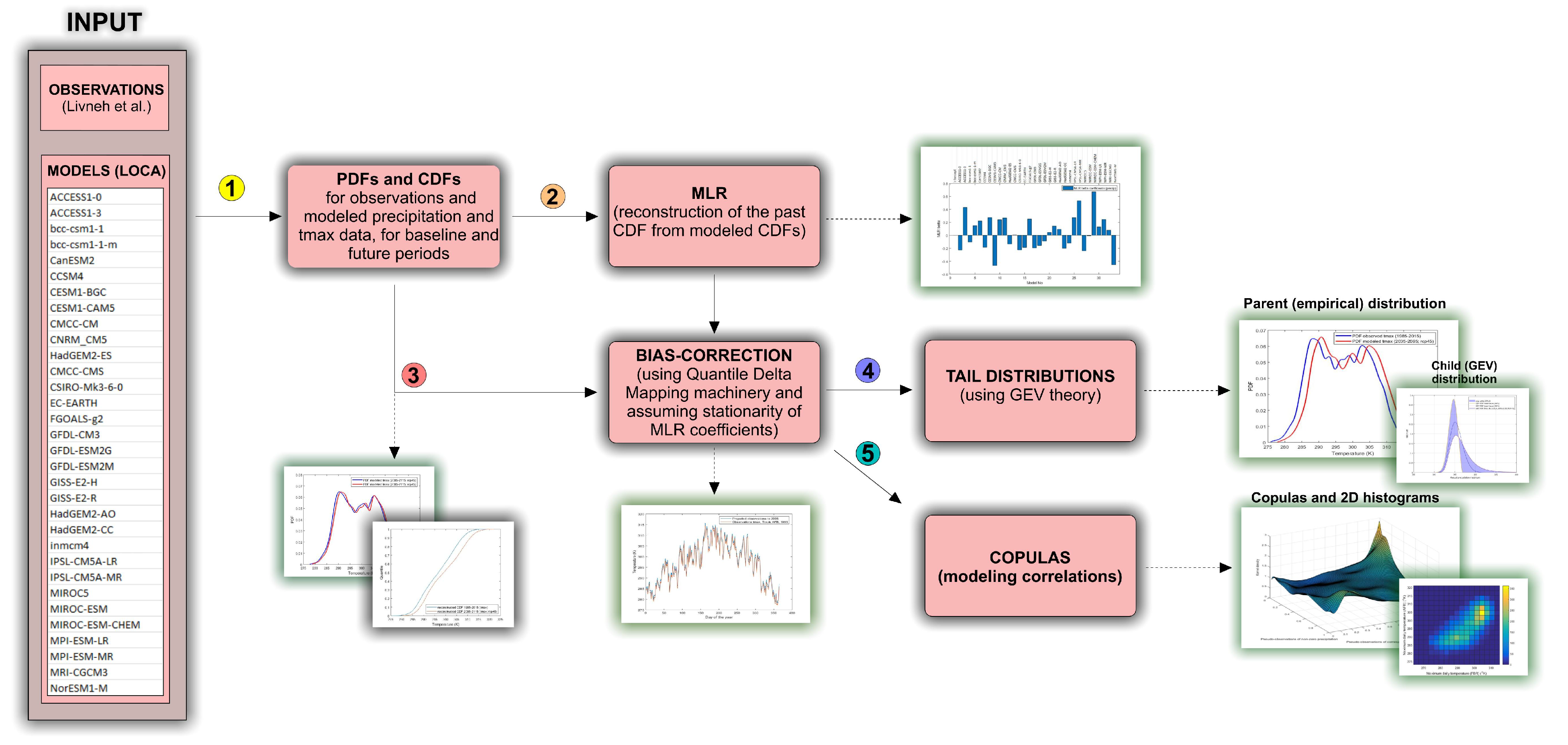
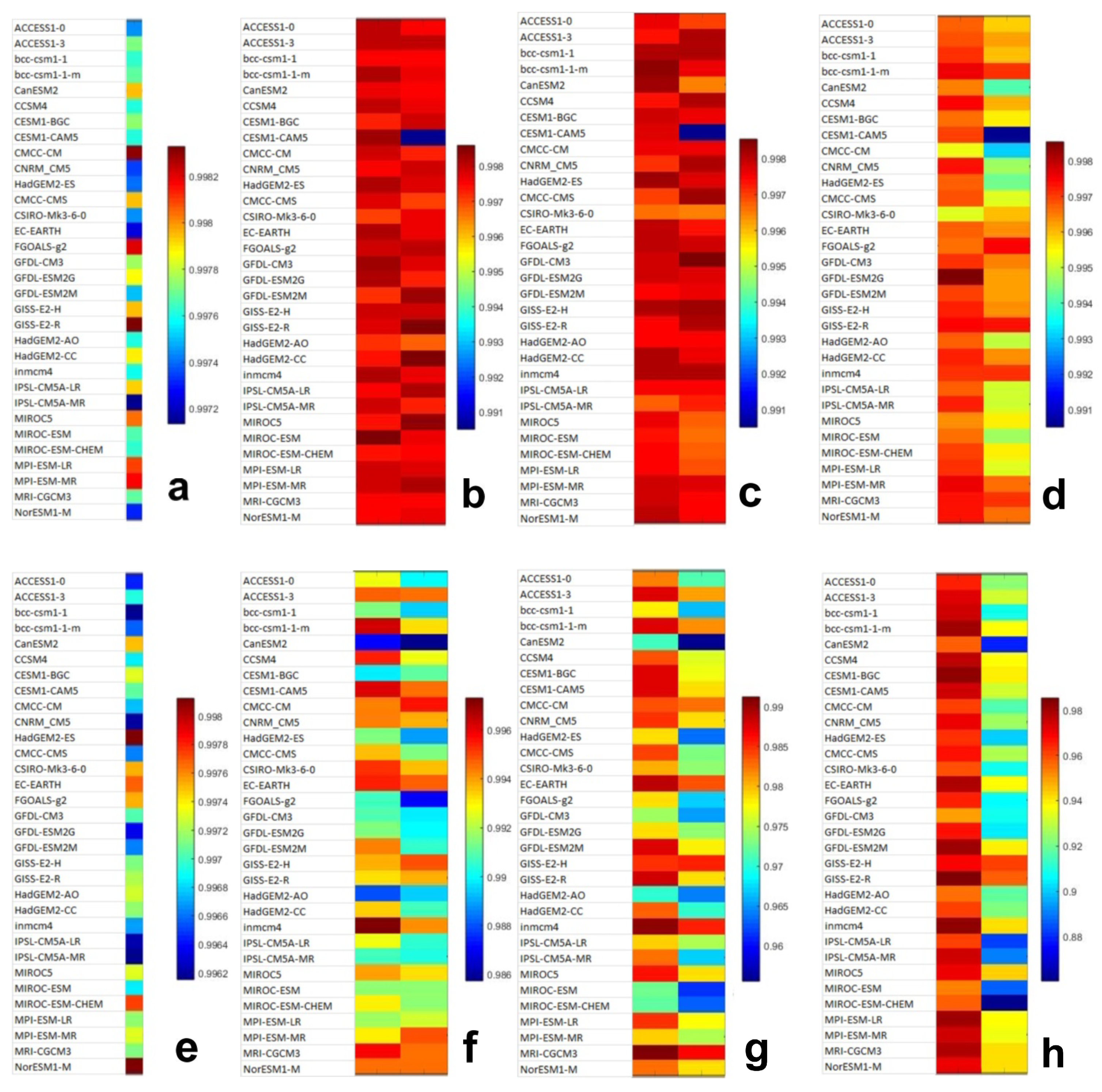
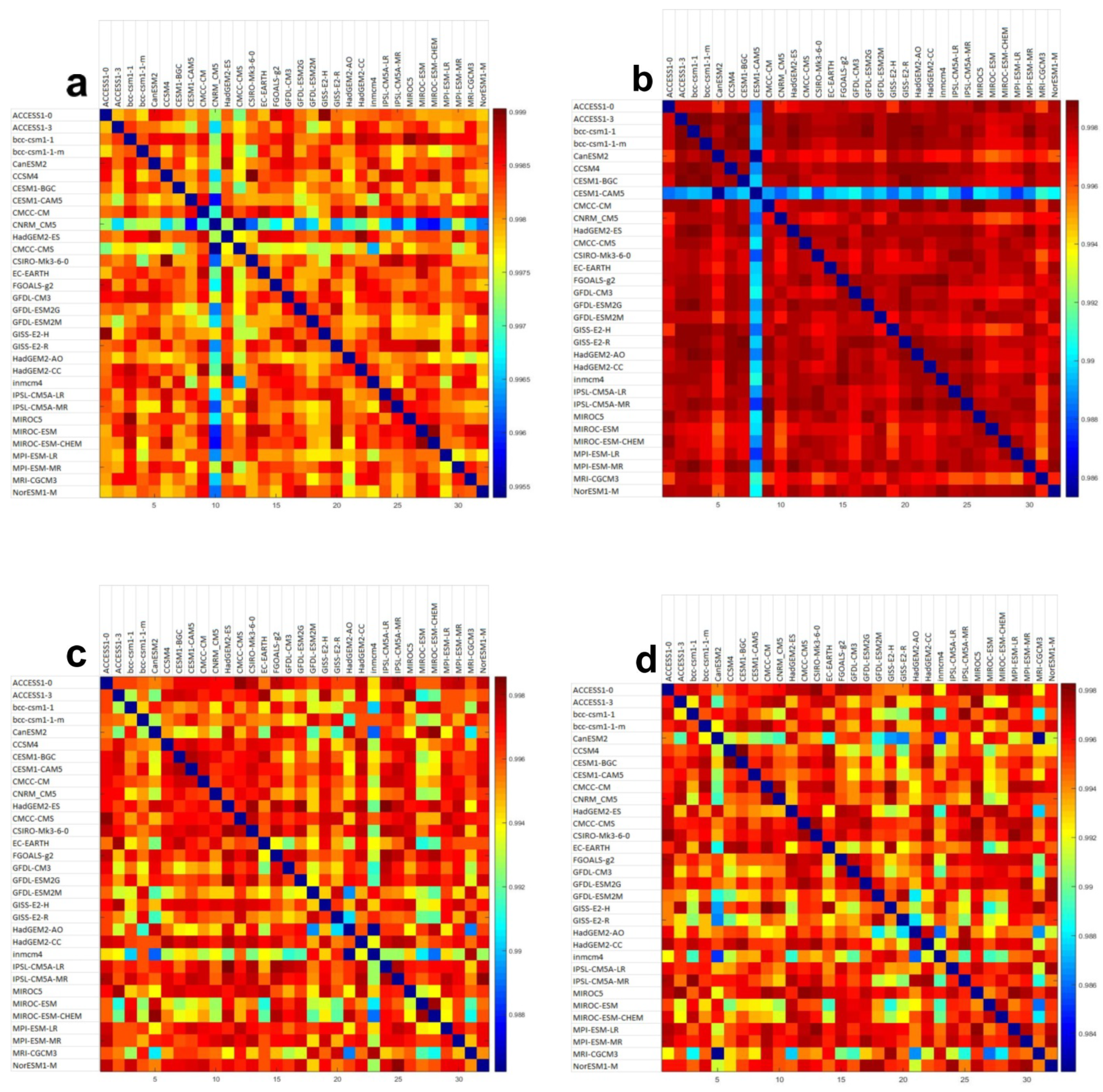
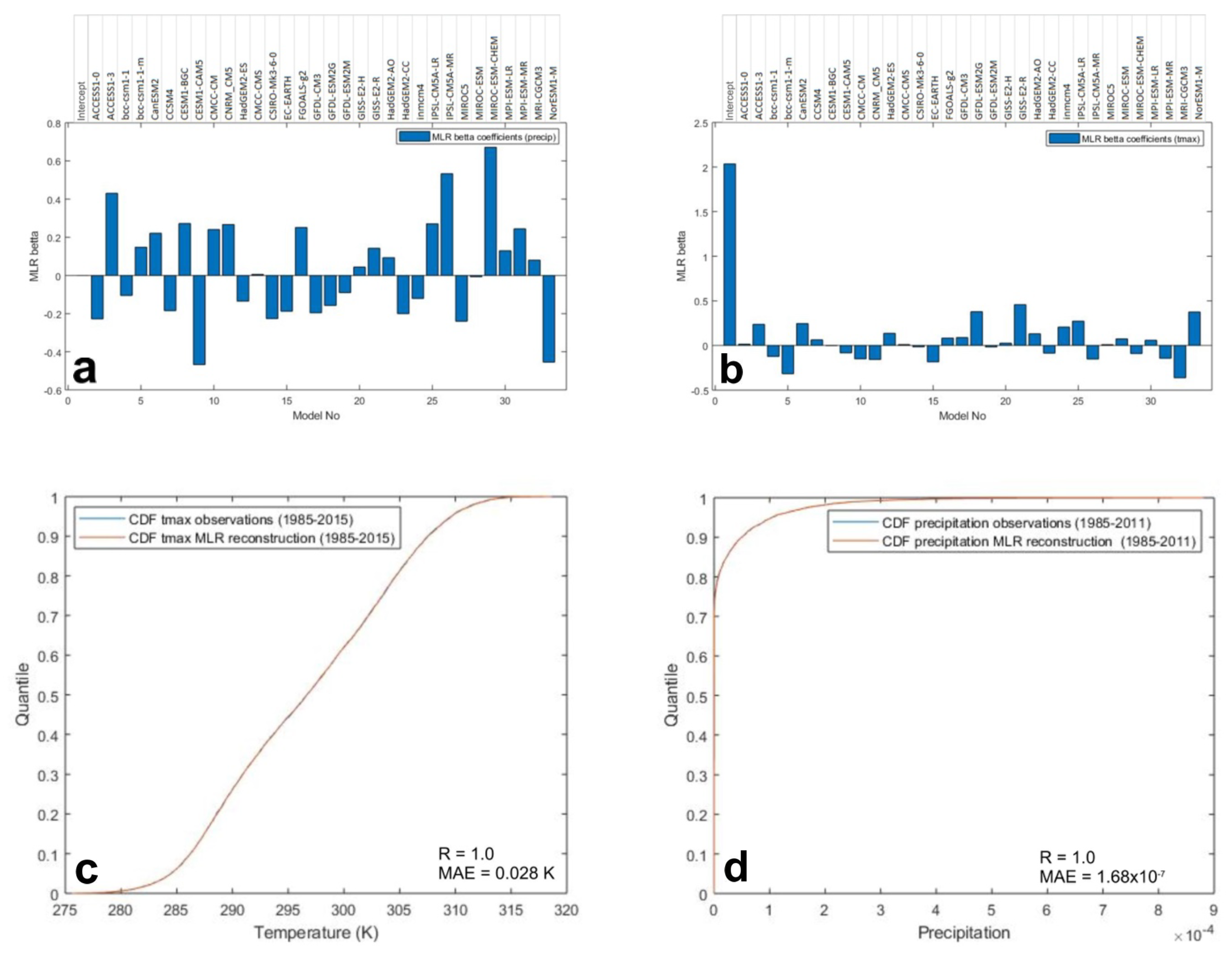
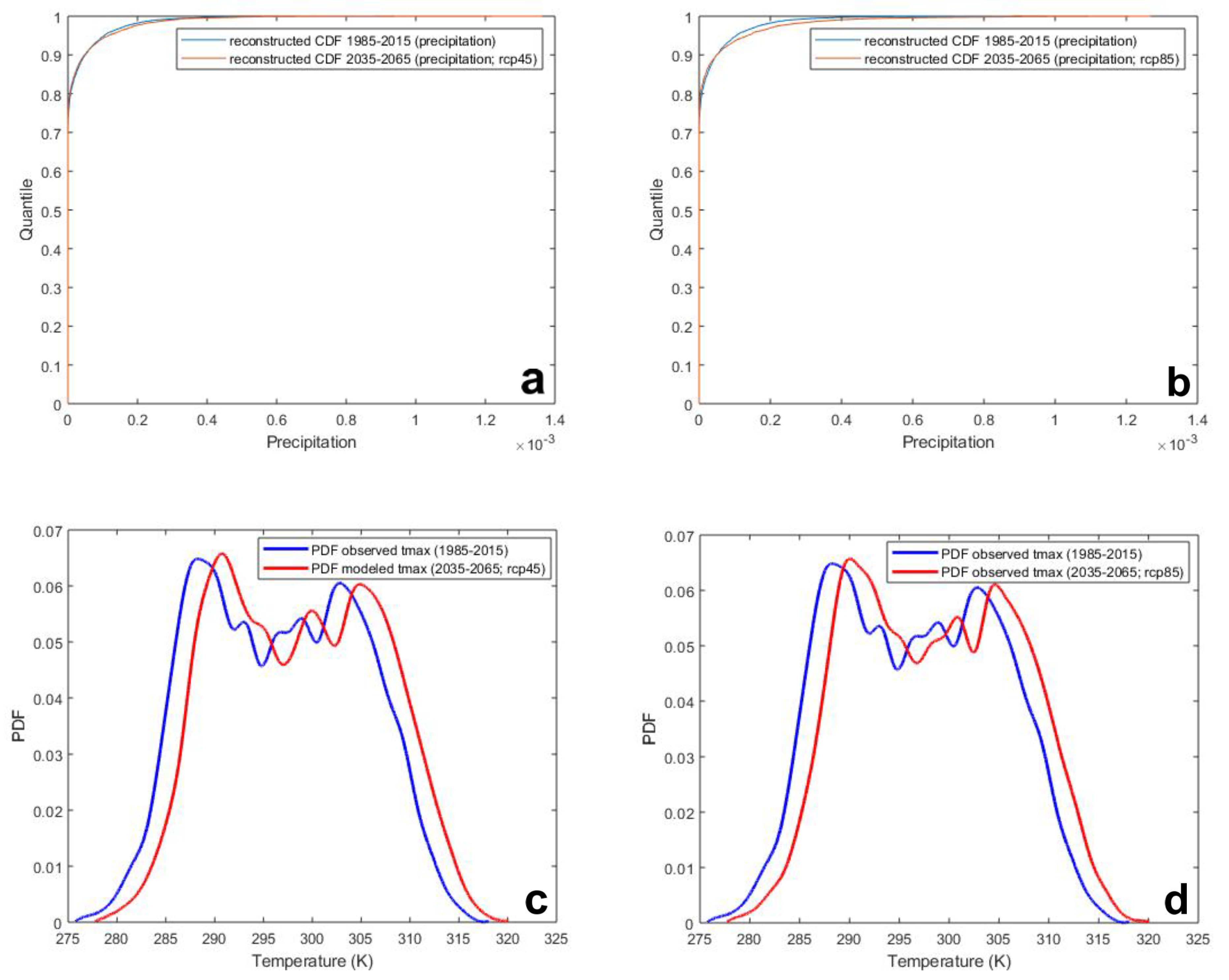

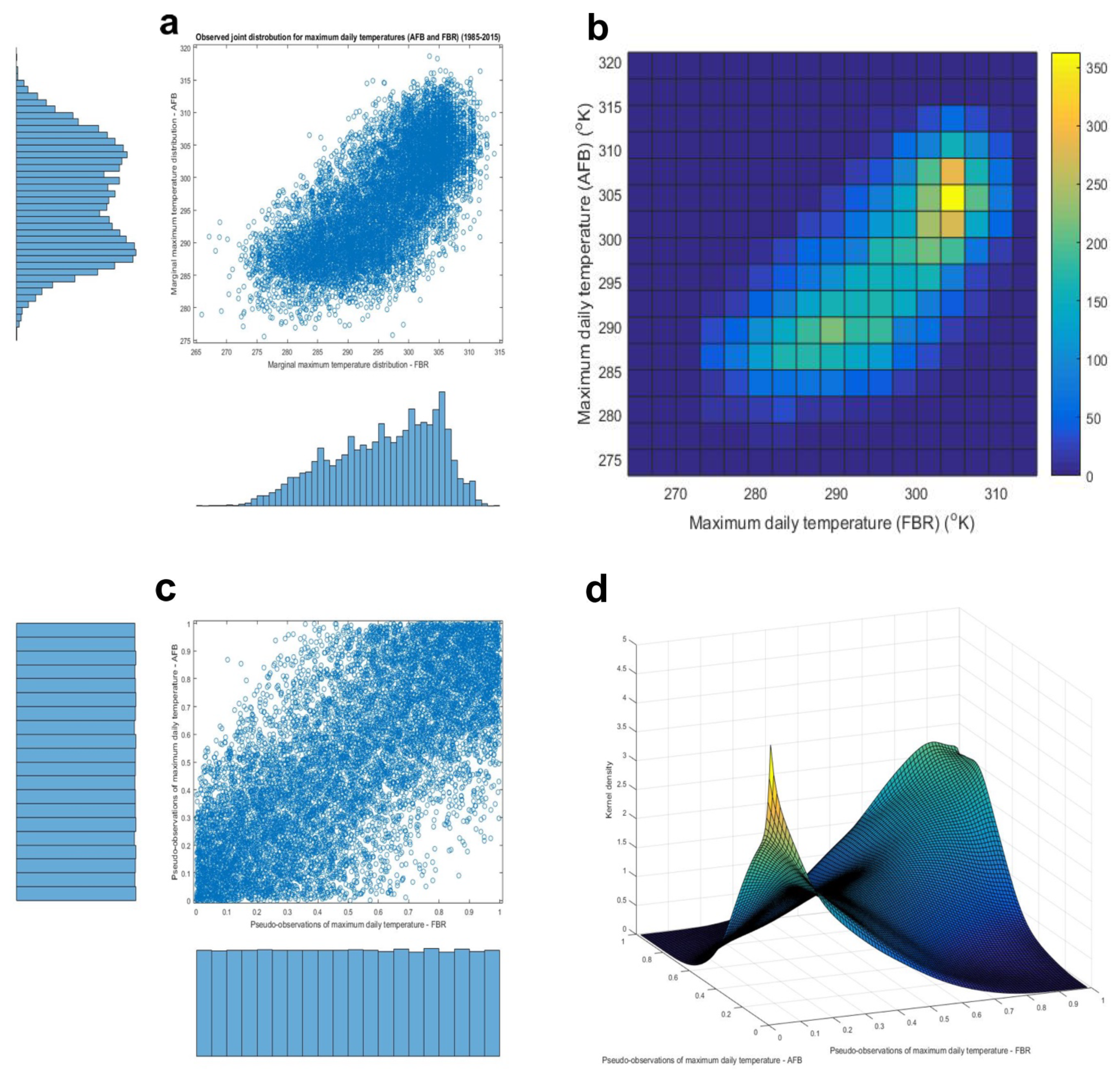
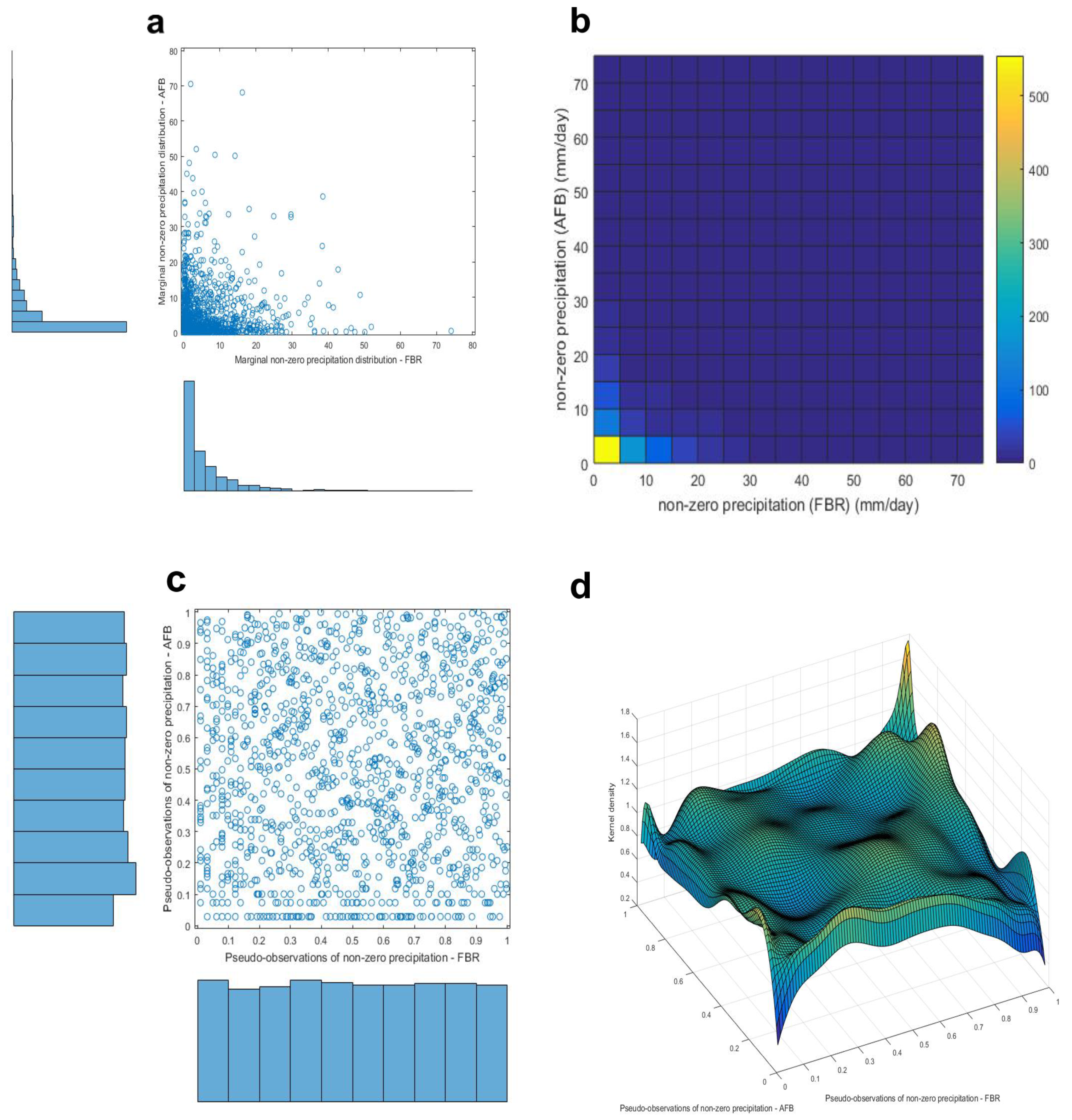
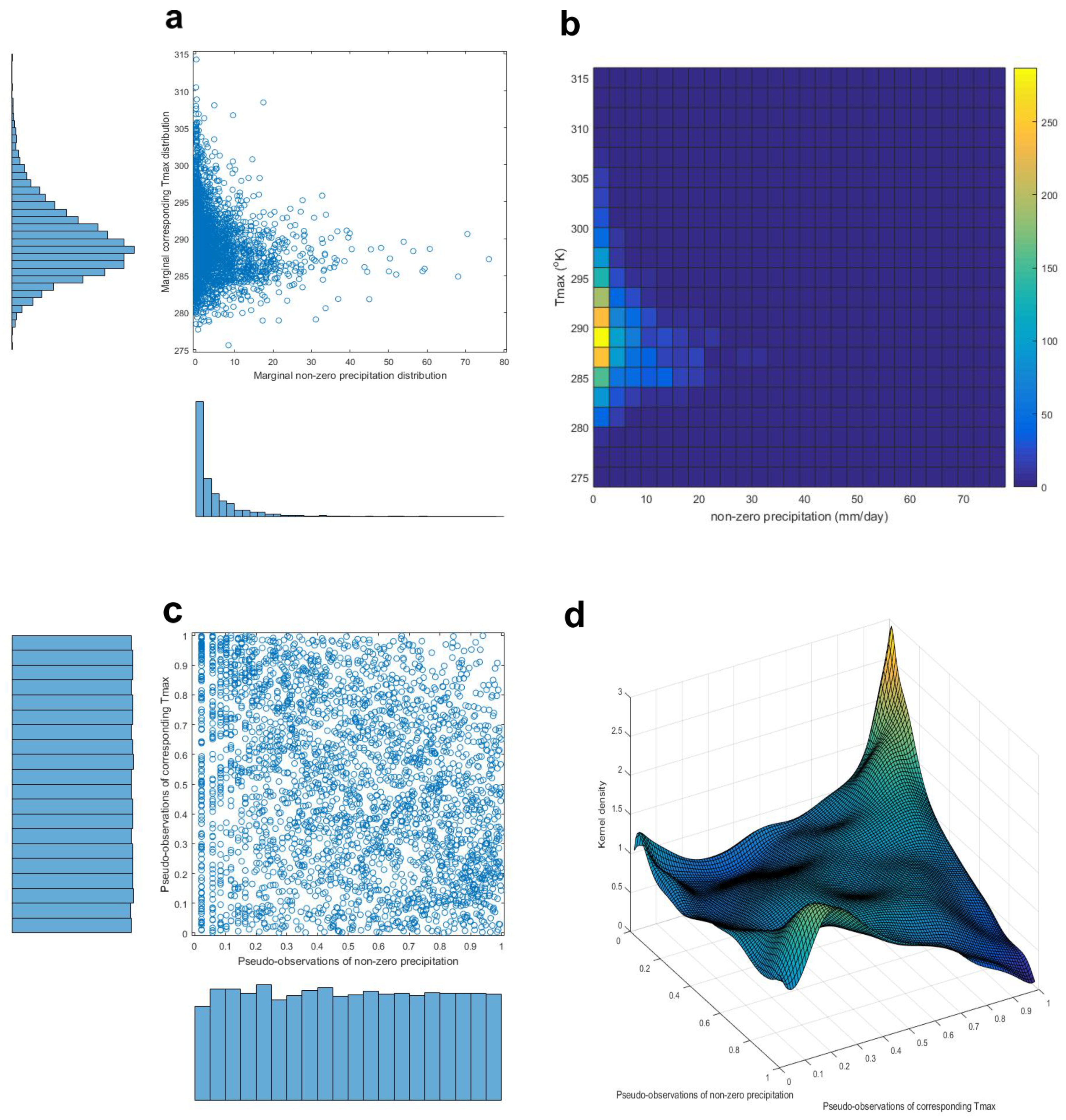
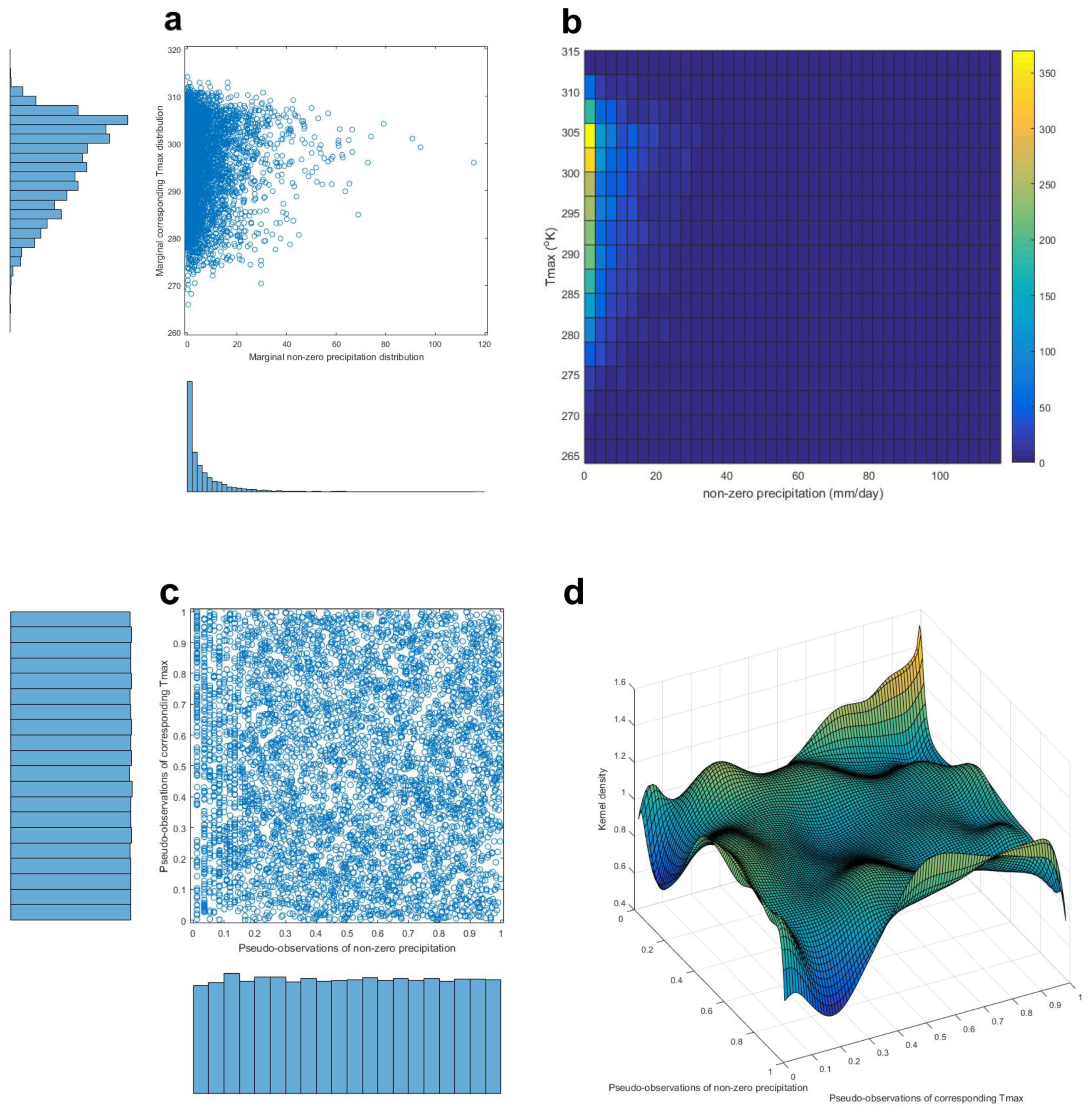
| AFB | FBR | |||||||
|---|---|---|---|---|---|---|---|---|
| RCP4.5 | RCP8.5 | RCP4.5 | RCP8.5 | |||||
| Year (Centered Around) | Precipitation (mm/day) (Delta) | Tmax (°C) (Delta) | Precipitation (mm/Day) (Delta) | Tmax (°C) (Delta) | Precipitation (mm/Day) (Delta) | Tmax (°C) (Delta) | Precipitation (mm/Day) (Delta) | Tmax (°C) (Delta) |
| 2020 | +0.1 | +1.1 | +0.2 | +1.1 | −0.5 | +0.9 | −0.3 | +0.1 |
| 2050 | −0.0 | +2.0 | +0.0 | +1.9 | −0.4 | +1.2 | −0.3 | +1.5 |
| 2100 | −0.1 | +2.2 | +0.0 | +2.7 | −0.5 | +1.6 | −0.4 | +2.2 |
| Observations, 1985–2011 | ||||
|---|---|---|---|---|
| AFB | FBR | |||
| Exceedance Probability (1985–2015) | Precipitation (mm/Day) (95% CI) | Tmax (K) (95% CI) | Precipitation (mm/Day) (95% CI) | Tmax (K) (95% CI) |
| P (0.05) | 70.4 (43.9–131.3) | 317.2 (315.1–320.3) | 94.9 (66.3–152.4) | 313.7 (311.5–317.6) |
| P (0.02) | 80.8 (46.0–183.1) | 317.9 (315.4–322.1) | 109.0 (70.1–204.7) | 314.1 (311.6–319.3 |
| P (0.01) | 88.4 (47.1–233.4) | 318.3 (315.6–323.5) | 119.8 (72.5–254.9) | 314.3 (311.6–320.4) |
| RCP4.5 | RCP8.5 | |||||
|---|---|---|---|---|---|---|
| Year (Centered Around) | Exceedance Probability | Precipitation (mm/Day) (95% CI) | Tmax (K) (95% CI) | Precipitation (mm/Day) (95% CI) | Tmax (K) (95% CI) | |
| AFB | 2005–2035 | P (0.05) | 73.8 (45.7–137.8) | 318.2 (316.1–321.8) | 80.2 (47.7–159.5) | 318.2 (316.2–321.6) |
| P (0.02) | 83.0 (47.5–185.5) | 318.9 (316.3–324.1) | 92.7 (50.0–227.8) | 319.0 (316.4–323.6) | ||
| P (0.01) | 89.1 (48.4–229.2) | 319.4 (316.4–325.9) | 101.7 (51.2–295.5) | 319.5 (316.6–325.2) | ||
| 2035–2065 | P (0.05) | 67.3 (44.3–109.1) | 319.1 (317.0–322.6) | 76.5 (46.2–138.0) | 319.1 (317.0–322.5) | |
| P (0.02) | 74.7 (46.5–135.1) | 319.8 (317.3–324.9) | 87.6 (49.9–183.3) | 319.9 (317.3–324.5) | ||
| P (0.01) | 79.5 (47.6–155.9) | 320.3 (317.4–326.6) | 95.2 (50.4–223.6) | 320.3 (317.4–325.9) | ||
| 2085–2115 | P (0.05) | 66.0 (43.4–103.2) | 319.3 (317.2–322.7) | 80.45 (46.4–155.8) | 319.9 (317.8–323.2) | |
| P (0.02) | 72.8 (45.7–123.5) | 320.1 (317.5–324.9) | 94.3 (49.5–219.4) | 320.6 (318.1–325.0) | ||
| P (0.01) | 77.0 (46.9–138.5) | 320.6 (317.7–326.6) | 104.3 (51.1–280.1) | 321.0 (318.2–326.4) | ||
| Year (centered around) | Exceedance Probability | Precipitation (mm/day) (95% CI) | Tmax (K) (95% CI) | Precipitation (mm/day) (95% CI) | Tmax (K) (95% CI) | |
| FBR | 2005–2035 | P (0.05) | 95.8 (65.9–140.6) | 314.5 (312.4–318.5) | 91.3 (64.1–136.3) | 313.9 (311.7–317.8) |
| P (0.02) | 105.6 (69.9–164.4) | 314.9 (312.4–320.0) | 103.2 (68.4–168.8) | 314.3 (311.8–319.5) | ||
| P (0.01) | 111.6 (72.1–181.4) | 315.0 (312.5–321.1) | 111.4 (71.0–195.6) | 314.5 (311.8–320.6) | ||
| 2035–2065 | P (0.05) | 93.5 (63.4–134.7) | 314.9 (312.7–318.7) | 92.5 (65.1–134.8) | 315.3 (313.1–319.1) | |
| P (0.02) | 103.4 (69.6–157.5) | 315.3 (312.8–320.2) | 103.1 (69.4–161.4) | 315.8 (313.3–320.8) | ||
| P (0.01) | 109.6 (72.0–173.8) | 315.5 (312.9–321.3) | 110.1 (71.8–181.8) | 316.1 (313.3–322.0) | ||
| 2085–2115 | P (0.05) | 94.6 (66.4–135.5) | 315.3 (313.1–319.4) | 93.0 (65.3–134.2) | 315.9 (313.7–319.8) | |
| P (0.02) | 104.1 (70.5–157.1) | 315.7 (313.2–321.1) | 103.2 (69.6–158.0) | 316.4 (313.9–321.4) | ||
| P (0.01) | 109.9 (72.8–172.2) | 315.9 (313.2–322.2) | 109.6 (72.0–175.4) | 316.6 (313.9–322.5) | ||
| AFB | FBR | |||||||
|---|---|---|---|---|---|---|---|---|
| Precipitation (mm/Day) (95% CI) | Tmax (K) (95% CI) | Precipitation (mm/Day) (95% CI) | Tmax (K) (95% CI) | |||||
| RCP4.5 | RCP8.5 | RCP4.5 | RCP8.5 | RCP4.5 | RCP8.5 | RCP4.5 | RCP8.5 | |
| 2005–2035 | 1.09 (0–16.5) | 2.77 (0–20) | 4.35 (0–21.4) | 4.63 (0–21.5) | 0.30 (0–10) | 0.47 (0–8) | 7.58 (0–35.5) | 1.86 (0–26) |
| 2035–2065 | 0.20 (0–11) | 1.87 (0–17) | 11.35 (0–31.1) | 11.63 (0–31.5) | 0.23 (0–9) | 0.33 (0–8) | 11.83 (0–38) | 17.65 (0–41.5) |
| 2085–2115 | 0.06 (0–10) | 2.97 (0–19) | 13.60 (0–33.4) | 22.45 (0.7–42.5) | 0.21 (0–9) | 0.25 (0–9) | 19.98 (0–45) | 31.04 (0–52.5) |
© 2020 by the authors. Licensee MDPI, Basel, Switzerland. This article is an open access article distributed under the terms and conditions of the Creative Commons Attribution (CC BY) license (http://creativecommons.org/licenses/by/4.0/).
Share and Cite
Tadić, J.M.; Biraud, S.C. Effects of Climate Change on Precipitation and the Maximum Daily Temperature (Tmax) at Two US Military Bases with Different Present-Day Climates. Climate 2020, 8, 18. https://doi.org/10.3390/cli8020018
Tadić JM, Biraud SC. Effects of Climate Change on Precipitation and the Maximum Daily Temperature (Tmax) at Two US Military Bases with Different Present-Day Climates. Climate. 2020; 8(2):18. https://doi.org/10.3390/cli8020018
Chicago/Turabian StyleTadić, Jovan M., and Sébastien C. Biraud. 2020. "Effects of Climate Change on Precipitation and the Maximum Daily Temperature (Tmax) at Two US Military Bases with Different Present-Day Climates" Climate 8, no. 2: 18. https://doi.org/10.3390/cli8020018
APA StyleTadić, J. M., & Biraud, S. C. (2020). Effects of Climate Change on Precipitation and the Maximum Daily Temperature (Tmax) at Two US Military Bases with Different Present-Day Climates. Climate, 8(2), 18. https://doi.org/10.3390/cli8020018





